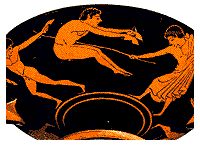Jumping
 Origin:
Origin:
The sport of jumping is linked to ancient Greek warfare. Considering that
the Greek countryside is covered by many ravines, soldiers' ability to jump
long distances would certainly have facilitated rapid movement across the
countryside during battle. In the ancient Olympic Games jumping existed
primarily as a component of the pentathlon, and was seldom held as a
singular event.
Equipment:
Unlike modern jumping, where the only equipment is the jumper's footwear, the
original Olympic athletes used stone or lead weights called halteres.
Halteres appeared in various shapes, some resembling dumb-bells or telephone
receivers. Others were simple cones with depressions so that the athlete could grip it.
The weight of them varied, from 1.610 kgrs to even 4.629 kgrs
(although the latter was a dedication to the god). They were used as a means to
increase the distance of a jump.
Rules:
The jumping pit was roughly 50 feet long. On one side of the pit was a
fixed point called the bater. The bater was the point from which
all jumps were measured. The length of the jump was recorded with a wooden rod called a
kanon. One difference between the ancient and the modern jumper was that the
former gained his forward acceleration by running up and swinging the weights.
A jumper held onto the weights until the end
of his flight, when he jettisoned them backwards. Then, he came down on the soil with his
feet together.
Characteristics of a Good Jumper:
A good jumper needed to be able to achieve great speed within the limited
runway distance. Power was important because a good spring off the bater was
necessary to achieve distance for the jump. Coordination was also
essential. This included figuring out and executing the synchronization of
kicking, of swinging the arms, and of throwing the weights into the air.
Additional Information:
The jump was considered one of the most difficult of the original Olympic
events, principally because of the timing and coordination. For this reason, the jump
was at times
accompanied by a flute player, whose sounds underlined the rhythm and
musical flow of a properly executed jump.
Boxing |
Discus |
Equestrian Events |
Javelin
Pankration |
Pentathlon |
Running |
Wrestling
Back
 Origin:
Origin: